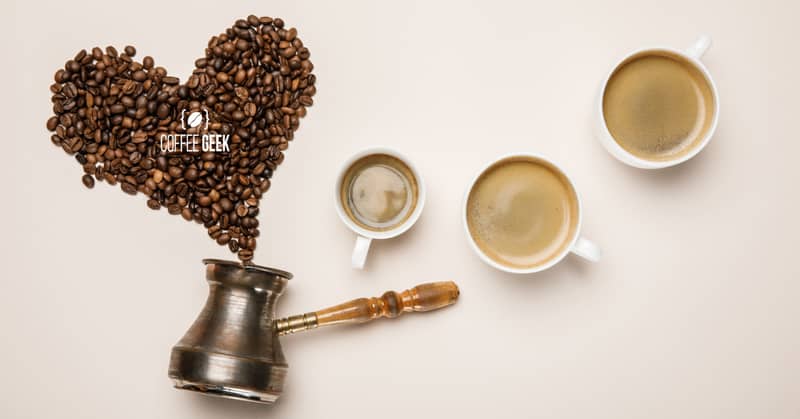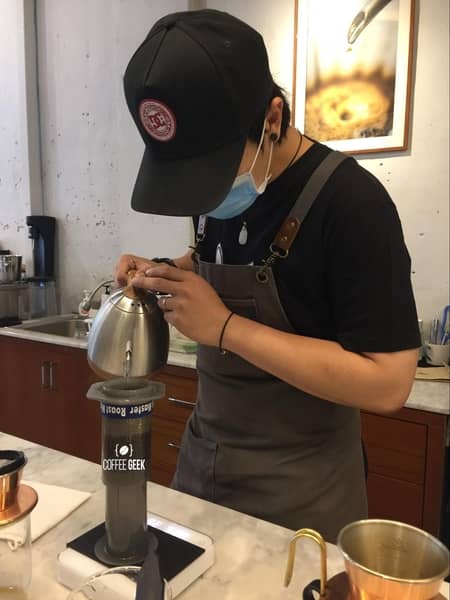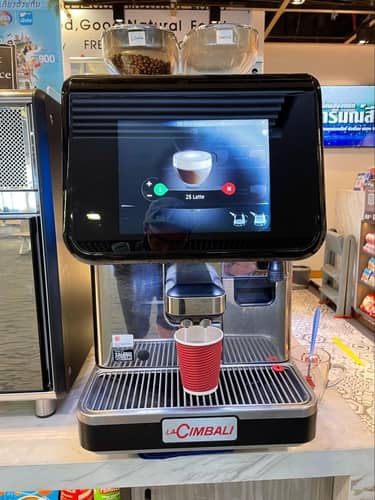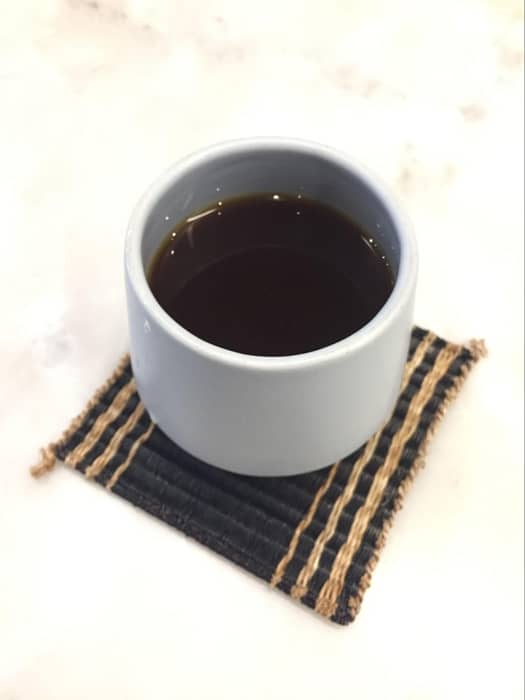We all know that caffeine is a stimulant. It perks us up, makes us feel more alert, and helps us stay focused.
But what’s the difference between the caffeine in espresso and coffee? How much caffeine is really in an espresso shot? And does drip-brewed coffee actually have more caffeine than espresso?
In this article, we’ll show you how much caffeine in espresso vs coffee can be expected, clear up some of the myths about caffeine in espresso and coffee, and help you figure out how to get the most out of your morning cup.
TL;DR: A shot of espresso contains around 63 mg of caffeine, while an 8-oz cup of regular Joe contains 90 – 120 mg. Does that mean espresso has less caffeine than coffee? Nope, it’s not that simple. Continue reading to find out why.
What Affects Caffeine Content In Coffee?
1. Type Of Coffee Beans
The 2 most common coffee species in the world are Arabica and Robusta coffee. Although Arabica has a milder and sweeter flavor profile that most coffee drinkers would prefer, Robusta generally contains more caffeine than its superior cousin (around 1.4 – 1.8 times more).
So, if you want a bit more of a caffeine kick from your brewed coffee, blend in a little bit of Robusta coffee. And this is applicable for both drip coffee and espresso shots.
In fact, the traditional espresso is popularly made with a blend of both Arabica and Robusta beans for a balanced taste and body and a stronger energy boost. Otherwise, stick to drinking 100% Arabica coffee if you want to cut down on your caffeine intake.
You can also try making a cup of coffee using 100% Robusta coffee. It’ll be very bitter, but pairing it with condensed milk and ice can turn it into an amazing cup.
2. Roast Profile
After you’ve got the coffee variety down, next, pay attention to the roast level of the coffee beans.
Many coffee lovers think that dark roasted coffee beans have the most caffeine because they can produce a more concentrated coffee drink that’s “stronger” and more intense.
But, different from popular beliefs, light roast beans usually have more caffeine than a dark roast, because some of the caffeine can get lost during the roasting and sublimation processes. So, if you want more caffeine in your cup of coffee, give the lighter roasts a try.
Additionally, a lot more of the original flavor compounds still remain in light roast coffee beans, giving your brewed coffee cup a brighter acidity with interesting flavor notes.
And don’t hesitate to try it with various espresso drinks! You don’t have to stick to darker roasts all the time. Feel free to experiment, especially if you’re a somewhat experienced home barista already. You might be surprised by the results.
3. Grind Size
So, how does the grind size of your coffee bean affect the caffeine levels of the final brewed coffee?
The grinding degree should match the brewing method to ensure optimal extraction of both flavors and caffeine, though it matters a lot more taste-wise.
So, if you’re trying to pull a neat espresso shot, make sure to use finely ground coffee.
For regular coffee brewed with a drip machine, a medium-size should be ideal.
For more information about the ideal grind sizes for different coffee brewing methods, check out the complete Grind Size Chart.
4. Brewing Time
The brewing time is how long the coffee is in contact with the hot water for extraction to take place. Like the grind size, it can also affect the caffeine concentration in the cup. But, it’s not a very important factor compared to others on this list.
Still, you should put in the effort to get it right for the sake of the flavor, body, and aroma of the final cup of coffee.
Each brewing method has a different optimal brew time. Make sure to do your homework before attempting to make a brew.
Otherwise, you may get stuck with under-extracted or over-extracted coffee, or worse… expelled!
5. Water Temperature
The temperature of the water can have a bigger impact on the extraction of caffeine levels than you might think.
According to a study in 2021, caffeine is reportedly quite soluble at 20 degrees Celsius (68 degrees Fahrenheit) with around 1.46 mg of caffeine per ml.
Its solubility increases at 80 degrees Celsius (176 degrees Fahrenheit) to 180 mg of caffeine per ml. It finally peaks at the boiling point – 100 degrees Celsius/212 degrees Fahrenheit – with around 670 mg of caffeine per ml.
So, generally, a higher water temperature accelerates the extraction of caffeine.
This explains why Cold Brew coffee that involves steeping coarse coffee grounds in cold water takes up to a whole day to finish brewing, whereas a regular black coffee brewed at 91 – 96 degrees Celsius (195 – 205 degrees Fahrenheit) only needs around 4 – 6 minutes.
So, when making hot coffee, be it an espresso shot or a black coffee, make sure to maintain the brewing temperature within the ideal range for a consistent extraction of flavors and caffeine.
6. Coffee-To-Water Ratio
This is likely the factor that has the biggest influence on the amount of caffeine that makes it into the final cup of coffee. Basically, the more coffee you use, the more caffeine can be expected to be extracted, since that’s the caffeine source.
So it’s understandable that methods that use more ground coffee and have a smaller difference between the amount of coffee grind and water boast a higher caffeine content per serving.
For example, the coffee-to-water ratio of a Normale espresso shot is only 1:3, which is why an espresso shot can be called an energy shot due to how packed it is. Moka Pots also produce pretty concentrated brews thanks to its 1:7 coffee-to-water ratio.
Keep in mind that the common Golden Ratio for a black coffee is around 1:17!
7. Brew Volume
As much of a big deal as the coffee-to-water ratio is, let me remind you that different brewing methods can yield different brew volumes.
Espresso shots can be made in a 1 or 2-oz (30 – 59 ml) serving size for a single or double shot of espresso.
This is a lot less than the size of a standard cup of coffee which is 8 – 10 oz (237 – 296 ml), so you can’t really fairly compare the two with each other. That’s not to mention the serving size for other types of brews as well.
That’s why when discussing the caffeine levels of different types of coffee drinks, we convert it to the amount in mg/ml or fluid ounce so that it’s easier for comparison.
Although espresso is well-known for being packed with caffeine, if you don’t pay attention to the amount of black coffee you drink in a day, you may end up consuming more caffeine than you would when entertaining a strong shot of espresso.
Another thing is, that there is more than one method to make black coffee, other than the good-ol drip machine, and each coffee maker can give a distinct result.
For example, according to a study, a cup of French Press, AeroPress, or Hario V60 can contain caffeine levels as low as 15 mg/oz only.
So, for the casual coffee drinkers trying to figure out their caffeine consumption, take into consideration the coffee recipes and the volume when drinking coffee.
8. Other Factors
Aside from the factors we’ve dived into so far, below are others that also may have an effect on the caffeine counts in your coffee:
- Origin: The climate and environmental elements affecting the growth of the coffee plant may influence its caffeine content as well.
- Exposure to light: Though this may depend on the species, shades can have a positive effect on the caffeine content.
- Altitude: The height above sea level the coffee plants are grown can positively influence the caffeine in Arabica beans, though not much data has been recorded to state the same for Robusta beans.
- Growing condition: Feeding nitrogen fertilizers to coffee plants can increase their amount of caffeine.
For more details, read this to learn exactly how to make stronger coffee!
How Much Caffeine Is In Espresso And Espresso Drinks?
How Much Caffeine Is In A Single Shot Of Espresso?
A shot of espresso (just one ounce) commonly contains around 63 mg of caffeine, according to the USDA.
But you can also manage to extract a very strong shot with as much as 121 – 133 mg of caffeine per oz using an espresso machine.
This should explain why a shot of espresso is often considered to be an energy shot. The high caffeine content can be mainly attributed to the brewing method which involves a fine grind size and a higher amount of coffee grounds.
How Much Caffeine Is In A Latte?
A caffe latte, or most other espresso-based coffee drinks, can contain either a single or double shot of espresso, depending on how much brew volume and strength the coffee drinker desires.
So your latte can have:
- With a single espresso shot: 63 – 133 mg/oz
- With a double espresso shot: 126 – 266 mg/oz
How Much Caffeine Does Mocha Starbucks Have?
A Caffè Mocha at Starbucks has:
- For a Short size (8 oz) with a single shot of espresso: 90 mg of caffeine
- For a Tall size (12 oz) with a single shot of espresso: 95 mg
- For a Grande size (16 oz) with a double shot: 175 mg
- For a Venti size (20 oz) with a double shot: 185 mg
Although a caffe mocha is also an espresso-based coffee drink, it can have more caffeine than other similar drinks due to additional caffeine content coming from the chocolate.
How Much Caffeine Is In A Cup Of Coffee?
How Strong Is Drip Coffee?
An average eight-ounce cup of regular coffee contains around 90 – 120 mg of caffeine, which means you can expect around 11 – 15 mg/oz.
Which Has More Caffeine Espresso Or Pour Over Coffee?
By concentration, espresso still has more caffeine than an average cup of Pour-Over coffee.
A study reports a brew made with a Hario V60 can contain around 22 mg of caffeine per oz, almost 3 times less than the average content of one shot of espresso – 63 mg.
Is French Press Stronger Than Regular Coffee?
Taste-wise, yes, it can be more powerful and fuller-bodied than black coffee because of the immersion brew method.
Caffeine-wise, the answer varies depending on who you ask. According to this study, a French Press or Plunger typically produces less caffeine than filter coffee, containing 6 – 15 mg/oz only, compared to drip coffee’s 11 – 15 mg/oz.
But, depending on varying factors (brew time, grind size), you can increase the caffeine content of your cup.
How Much Strong Is Moka Pot Coffee?
The caffeine content of Moka Pot coffee can range from 21 to as high as 160 mg per oz, definitely on par with espresso. That’s why Moka Pot coffee is often praised for being a great espresso alternative for its bold coffee taste, heavy body, and high caffeine content.
How Much Caffeine In A Cup Of Coffee Is Too Much?
According to the FDA, for healthy adults, the maximum recommended amount of caffeine is 400 mg a day, which is about four or five cups of coffee. So too much caffeine would be above 400 mg/day.
However, the sensitivity to the effects of caffeine and the metabolizing (breaking down the caffeine content) speed of each person can be very different from each other.
So if you have certain conditions or are on certain medications that can make you become more sensitive to caffeine, make sure to talk to your health care provider to know your limits. This also applies if you’re pregnant, trying for a baby, or breastfeeding.
Here are some symptoms that may appear when you’ve consumed more caffeine than what you can handle:
- Nausea
- Jitters
- Anxiousness
- Faster heart rate
- Sick stomach
- Headache
- Dysphoria
Does Decaf Coffee Have Caffeine?
Despite its name, brewed decaf coffee, including decaf espresso and instant decaf coffee, does have caffeine in it. However, the caffeine content is much lower than that of regular coffee.
Most decaf coffees have less than 2.5% caffeine, which is around 2 mg of caffeine only, compared to 95 mg of a regular cup.
The decaffeination process can remove most of the caffeine from the beans, but some caffeine always remains. The caffeine is removed by using either solvent-based or non-solvent-based processes, among which the Swiss Water method can remove up to 99.9%!

For people who are sensitive to caffeine, decaf coffee may still be too stimulating. However, for most people, decaf coffee is a good way to enjoy the flavor of coffee without the side effects of caffeine.
So, decaf is not completely caffeine-free, but it’s close. If you’re sensitive to caffeine or are trying to cut back, decaf is a safe and healthy choice for most people.
There’s no evidence that suggests drinking coffee that’s decaf can be harmful unless you suffer from conditions that make you sensitive to even a small dose of caffeine.
Otherwise, it’s a great alternative to caffeinated coffee that can help you avoid caffeine-induced symptoms like anxiety and certain heart problems.
If you’re looking for some decaf Starbucks drinks to try at your favorite local coffee shop, check out our newest bucket lists!
To Wrap Up
Now that you know how much caffeine is in espresso and other popular coffee drinks, you can make a more informed decision on which coffee to drink.
If you’re looking for a strong coffee with lots of caffeine, espresso is your best bet. But if you’re looking for a less caffeine-packed drink, choose drip coffee or French Press instead.
FAQs
Is 4 Shots Of Espresso A Lot Of Caffeine?
It depends on how the espresso is prepared. A shot of espresso can contain around 63 mg of caffeine on average or more, so 4 shots can have 252 mg of caffeine or more. Just make sure your daily consumption stays below 400 mg (for a healthy adult) to be on the safe side.
Is There Any Decaf Coffee That Is 100% Caffeine Free?
No, no decaf coffee is 100% caffeine-free. But the Swiss Water method can remove almost all of it (99.9%).
Does Coffee Lose Caffeine Over Time?
No, the caffeine levels of coffee beans won’t decrease over time, don’t worry. But, the volatile matter is affected. Your grounds will lose their delicious flavors quickly if you don’t brew them right away.
So make sure to invest in a quality grinder and grind the coffee bean right before brewing to best preserve the freshness.
Even if you buy whole-bean coffee beans, the flavor compounds will still get lost over time, especially if you don’t store them properly in an opaque, air-tight container at room temperature.

![How Much Caffeine in Espresso vs Coffee? [Myths Busted] 2 How Much Caffeine in Espresso vs Coffee?](https://coffeegeek.tv/wp-content/uploads/2022/04/Webp.net-compress-image-1-2.jpg)





